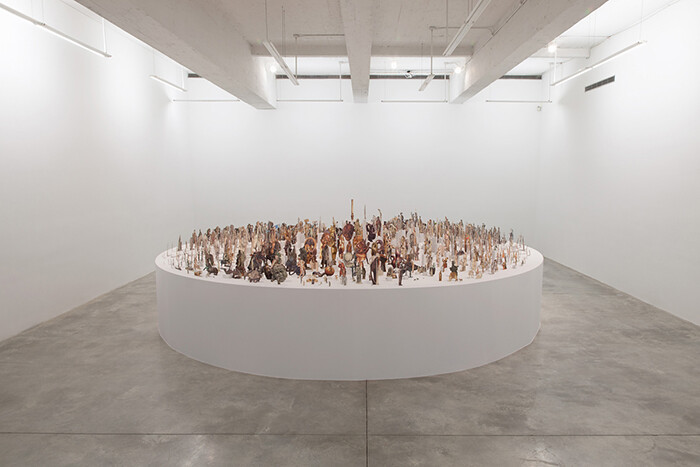If some version of the afterlife exists, and if Aby Warburg manages to find a little peace there, he might be pleased to see Geoffrey Farmer’s “Cut Nothing, Cut Parts, Cut the Whole, Cut the Order of Time” at New York’s Casey Kaplan. During the last few years of his life, Warburg famously worked on Mnemosyne Atlas (1924–1929), a collection of nearly one thousand images divided thematically and pinned to wooden panels. Though primarily art-historical (and heavy on the Italian Renaissance), these black-and-white reproductions were supplemented with maps, cosmological and mathematical formulas, text, and newspaper photos. While diachronically charting the evolution of an image or motif through time (“ascent to the sun,” for instance), Mnemosyne Atlas also makes synchronic connections across cultures and metaphor. The result is a project that combines the deep knowledge of the scholar with the associational logic of the poet, both amplified by a sense of iconography as always alive: Warburg’s panels are a kind of animistic art history (and prophetically proto-digital).
Farmer’s Leaves of Grass (2012) was among the most memorable works at Documenta 13 in 2012. Using approximately 16,000 images clipped from issues of LIFE magazine spanning 1935–1985 and affixed to thin sticks, he created a 124-foot-long installation that pans chronologically while also containing thematic clusters (color photographs of processed food, for instance). In the middle gallery at Farmer’s current exhibition, the horizontal timeline plinth has been reshaped into a circle, and the images concern the history of (mostly) Western sculpture from the ancient Greeks to the 1960s. Utilizing hundreds of reproductions from decommissioned art-history textbooks, Boneyard (2013) evokes Mnemosyne Atlas while displaying a more circumscribed scope that is closer to cultural diorama than Warburg’s inspired tropological collage. Yet one of Farmer’s important points here is that archives exclude as much as they include, that their silencing of other knowledges and discourses helps feed their power.
Warburg was prescient in attempting to look outside the box of art history’s nineteenth-century origins in nation-state chauvinism, but the various canons of the humanities needed the political activism of the 1960s to happen before they really began to shake. Boneyard turns the history of Western European sculpture into an informal and somewhat archaic-looking cemetery of sorts, with certain figural motifs receiving shared plots in the arrangement: children, slaves, Davids, nudes, etc. However, the research and care that went into selecting, excising, gluing to sticks, and arranging these images reanimates them, a process echoed throughout the exhibition. Four repurposed archival photographs open the show, two of musicians with stringed instruments, two playing wind instruments (respectively assigned the titular categories Plucker and Blowers [all 2014]), and each representing a different culture. A single audio speaker emits clicks and cuts along with snippets of archival sound in keeping with the overall collage aesthetic, one in which history has been flattened out both formally and conceptually.
This is most apparent in the back gallery, which contains the digital slideshow of found images Look in my face; my name is Might-have-been; I am also called No-more, Too-late, Farewell. (2013–14), a title lifted from a sonnet by Dante Gabriel Rossetti. The computer-generated sequencing produces thematic and formal taxonomies—workers, animals, cigarettes, portraits, and so on—that in turn seem at least partially synched to a lone speaker matching the one in the first gallery. Along with determining the order in which the photographs appear, the computer selects the editing technique: speeding up and slowing down the pace of the slideshow; making a quick edit or slow dissolve. As indicated by the installation’s title, both sound and image feel slightly out of date, as if history mainly serves as a prelude to the present. Images are sometimes badly pixelated; the audio crackles with scratches and static. Overall, the slideshow has the feel of an updated Family of Man, with its anthropologically shared rituals, performances, and labor, from cultures around the globe.
The archival impulse in art was originally intended to be an intervention into history, whether uncovering silenced narratives or challenging standard ones. Farmer expands this approach into something more encyclopedic and algorithmic, with an accompanying loss of affect. As a result, there’s something that feels a bit thin about “Cut Nothing, Cut Parts, Cut the Whole, Cut the Order of Time,” compounded by its abundance of “two-dimensional” imagery, however purposeful. Even its press release eschews explanation in favor of a web of personal memory. Of course, this looseness is meant to create a space for the gallery-goer to participate in the generation of visual meaning and historical connection. As an artist who once worked more conventionally with sculpture and multimedia, Farmer displays a subtle understanding of how bodies move through a room to encounter image, object, and sound while becoming elements in a much larger collage.









